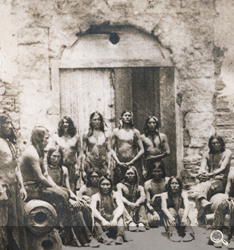

"Kill the Indian and Save the Man"
Fort Marion prisoners were encouraged to draw by their warden and former adversary, Richard Henry Pratt. Pratt’s philosophy of “kill the Indian and save the man” stressed “civilizing” the Indians by teaching them English, converting them to Christianity, and giving them a trade. Pratt supplied the equipment for the drawings and other Indian arts and crafts to promote his plan.
In 1878, after completing their prison sentences, seventeen of his charges entered the Hampton Normal and Agricultural Institute in Virginia, founded as a school for African Americans. Others attended Pratt’s new Indian Industrial School in Carlisle, Pennsylvania. More than 10,000 students, both men and women, were instructed there in trades such as farming, carpentry, and domestic arts. Pratt’s school remained open until 1918. Twenty-six other schools were founded on the Carlisle model, several of them on the sites of old military posts.
Plains Indian prisoners arriving at Fort Marion, Florida Unknown photographer, about 1875 Courtesy Yale Collection of Western Americana, Beinecke Rare Book and Manuscript Library, Image: 1004474
St. Augustine Indians at Hampton, Summer, 1878 Unknown photographer 13 of the 17 Fort Marion students “with spade and hoe, awl and hammer.” Front Row, left to right: White Bear (Arapahoe), To-un-keah (Kiowa), Ohettoint (Kiowa), Little Chief (Cheyenne), Matches (Cheyenne); Back Row, left to right: Nick Pratt (Cheyenne), Bear’s Heart (Cheyenne), White Man (Cheyenne), Etadleuh (Kiowa), Koba (Kiowa), Tich-ke-matse (Squint Eyes, Cheyenne), Roman Nose (Kiowa), Tsadletah (Kiowa). Courtesy Hampton University Archives.

